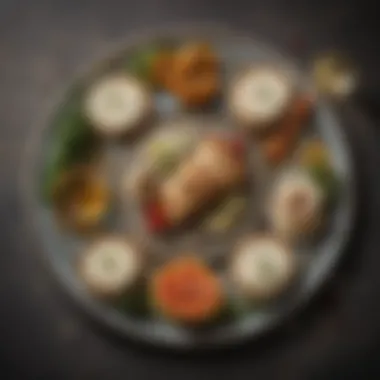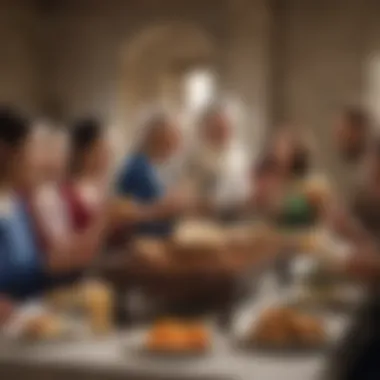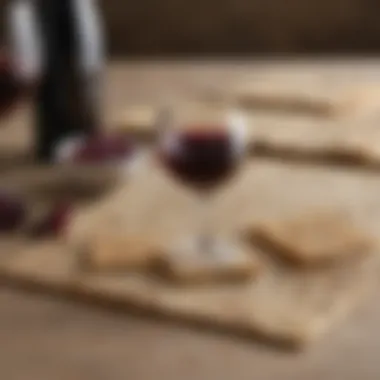Understanding the Seder Meal: A Deep Dive into Passover Traditions


Intro
The Seder meal stands as a cornerstone of Jewish Passover traditions, merging history, spirituality, and cultural identity into a single event. This article examines the Seder's significance, starting from its historical background to the intricate beliefs woven into its practice. The meal is not merely an occasion to dine; it is an educational experience that facilitates the transmission of wisdom and values across generations. Indeed, the Seder emblemizes a rich tapestry of traditions that bind together family and community.
As we delve into the components of the Seder meal, we will explore the symbols within the meal, significant rituals, and the emotional depth that it brings to those who partake in this special observance. Let’s enrich our understanding of the Seder meal, elucidate its enduring relevance, and appreciate how it serves as a vital aspect of Jewish life.
Recipe Highlight
Charoset: A Sweet Tradition
Charoset is a symbolic dish featured during the Seder meal. Its sweet taste serves to contrast the bitterness of slavery, representing the mortar used by Jewish slaves in Egypt. Charoset is cherished for its flavorful blend of fruits and nuts.
Essential Ingredients:
- Apples
- Walnuts
- Honey
- Cinnamon
- Red wine
Estimated Preparation Time: 20 minutes
Servings: 8
Step-by-Step Instructions
- Peel and core the apples, then chop them into small pieces.
- In a mixing bowl, combine the chopped apples with finely chopped walnuts.
- Add honey and a sprinkle of cinnamon, adjusting to taste.
- Pour in red wine, then mix the ingredients until well combined.
- Chill in the refrigerator for flavors to blend before serving.
Cooking Techniques:
Make sure to cut the apples uniformly for an even texture. You can use a food processor if you prefer a smoother consistency.
Insider Advice:
Consider changing ratios based on personal preference. Also, keep an eye on common basics like nut allergies when planning your meal.
Variations and Substitutions
For those looking for variations, try using poor pears instead of apples.
Here are common substitutions:
- Nuts: Substitute walnuts with pecans or almonds to change the texture.
- Sweetener: Maple syrup could replace honey for a different taste.
Add Flair:
Add a splash of lemon juice for a hint of freshness.
Pairing Suggestions:
Charoset pairs extremely well with matzo during the Seder meal. Try it as a topping on matzo for the perfect bite.
Time-Saving Cooking Tips
Streamline your prep by applying these methods:
- Chop Ahead: Dice apples and nuts a day in advance.
- Tools: Use a good quality food processor for faster blending of ingredients.
- Prep Multiple Meals: Charoset can be made alongside other Passover dishes to share the workload. Consider preparing other Passover sides concurrently to save time.
Nutritional Information
A serving of charoset provides approximately 150 calories.
Key nutrients include:
- Fiber: From apples and walnuts, beneficial for digestion.
- Natural Sugars: From fruits, offering quick energy.
This dish fits well in various diet plans, being vegan and relatively gluten-free, satisfy a diverse range of dietary needs.


The Seder meal is not just food; it represents a dialogue, a narrative bridging past and present, rejuvenating cultural and familial ties.
Ultimately, the Seder meal’s profound feelings enable a rich experience of gathering, immersed in history, continuity, and hope.
Intro to the Seder Meal
The Seder meal holds a position of monumental importance within Jewish culture, particularly during the Passover festival. At its core, the Seder meal is not merely a tradition; it embodies centuries of history, spirituality, and education. This introduction presents the Seder as a necessary practice that integrates the Jewish community, emphasizing values such as resilience and remembrance.
Definition of the Seder
The term Seder comes from the Hebrew word for order. It denotes the order of the rituals and elements involved in this ceremonial dinner, typically held on the first two nights of Passover. The Seder meal is structured around specific readings, songs, and symbolic foods that narrate the story of the Exodus from Egypt. By practicing these rites, Jews connect with their ancestral past.
Additionally, the Seder includes the reading of the Haggadah. This text serves as a guide to the evening's proceedings, detailing the various rituals and ensuring that the story is passed down through generations. Central to the Seder's experience is the communal aspect, where family and friends gather, share, and reflect on their shared heritage.
Importance in Jewish Tradition
The significance of the Seder in Jewish tradition stretches beyond the act of eating. It serves as a bridge linking past and present, fostering a sense of identity and belonging. The Seder allows participants to express gratitude, celebrate freedom, and learn moral lessons central to Jewish teachings.
One of the essential aspects is the emphasis on storytelling. The Seder meal fosters dialogue between generations, particularly through the Four Questions. This encourages curiosity and offers children a role in the practice, highlighting their importance within the community.
Maintaining traditions like the Seder enriches the Jewish experience, making it relevant for modern communities. Family rituals become a source of comfort and instruct notable cultural values. Furthermore, this meal is infused with opportunities for spiritual reflection and personal growth, making the Seder a pivotal element of Jewish life today.
“The Seder meal helps Jewish individuals and families reconnect with their faith and heritage.”
Historical Context of Passover
The historical context of Passover forms the backbone for understanding the Seder meal's significance within Jewish culture. Recognizing the past offers insight into how traditions evolve and why certain practices are embedded.
Additionally, a nuanced comprehension of these historical trajectories gives depth to the rituals performed, allowing one to appreciate their relevance today. The story of Passover goes beyond mere reminiscence; it embodies themes of liberation, resilience, and identity.
Origins of Passover
The origin of Passover traces back to the biblical tale found in the Book of Exodus. This narrative recounts the Israelites' escape from Egyptian bondage. The key moment came when the Angel of Death passed over the homes marked with lamb's blood, sparing the inhabitants. This event, marking liberation, is a fundamental theme that resonates deeply within the Jewish ethos.
Historically, Passover is linked to springtime, symbolizing renewal and rebirth. Bread made without leaven represents haste of departure from Egypt. These roots translate into various rituals present today, each carefully preserved across generations.
Development of Seder Practices
Seder practices gradually developed after the destruction of the Second Temple in 70 CE. Home rituals began to gain prominence, marking a shift from temple-centric worship to family-centered observance. The guidelines outlined in the Haggadah became critical during this time. They shaped the sequence and meaning of the Seder meal to ensure themes of freedom and story-telling persist.
Different Jewish communities introduced unique customs over time. For example, Sephardic Jews have their elaborate versions of the meal, often involving specific spices and prayers. In contrast, Ashkenazic traditions embrace pastries and fewer decorative elements. This diverse evolution enriches contemporary observance by allowing room for personal expression while respecting historical origins.
Structure of the Seder Meal
The Seder meal is not merely a dining experience; it serves as a ritual, a remembrance of the enslaved Jewish past, and a celebration of liberation. Understanding the structure of the Seder meal is crucial, as it encapsulates key traditions and symbolic actions pivotal to the Passover commemoration. This section dissects the various elements, benefits, and considerations inherent in the Seder's structure, revealing the intentions and teachings central to this Jewish observance.
Components of the Seder Plate
The Seder plate holds significant meaning, housing items that reflect various aspects of the Passover story. Each component provides sensory richness, taste, and lesson, making the meal engaging and educational. Let's explore the elements that altogether create a unique tapestry of memory and teaching.
Maror (Bitter Herbs)


Maror represents the bitterness of slavery. This component is essential, as it allows participants to physically and spiritually connect with the hardships faced by their ancestors. Commonly, horseradish is used due to its pungent taste, which triggers tears, paralleling the suffering endured. Maror's bitter characteristic is impactful; it reminds everyone of the pain and sorrow embedded in Jewish history. Thus, this choice holds not just culinary purpose but is deeply symbolic and significant.
Charoset
Charoset offers a counter-narrative to the bitterness of maror. This sweet mixture, often made from apples, nuts, wine, and spices, suggests the mortar used by Jewish slaves to build in Egypt. The sweetness of charoset serves multiple purposes. It highlights resilience and offers hope. Participants often cherish this component for its pleasant flavor, adding a comforting layer to an otherwise heavy narrative. It balances the Seder plate, providing taste that rings memory that Jewish identity perseveres amidst difficulty.
Zeroa (Shank Bone)
Zeroa, typically a roasted shank bone, symbolizes the Paschal sacrifice made during the Exodus. It is not eaten during the Seder; instead, it stands as a powerful witness to historical events, connecting participants to ancestral traditions. Its use as a non-consumable component leads to reflections on purity and sacrifice in Jewish law. This aspect elevates not only the Seder meal but also unites participants in a broader spiritual conversation about historical observance.
Karpas (Vegetable)
Karpas, often parsley or celery, is another important element. Participants dip it into salt water at the beginning of the Seder, symbolizing tears shed during slavery. This action serves as a metaphor for renewal, awakening participants to the evening’s deeper reflections. Karpas is significant because it invites participants to engage with the ritual from the very onset, blending sustenance with symbolism. It is refreshing amid more pungent flavors, emphasizing beginnings in Jewish storytelling.
Chazeret
Chazeret is often a second bitter herb, used in addition to maror. Though it might seem redundant, it highlights the nuances of bitter experience. Some interpret it through the lens of Hillel's sandwich, a practice that encourages combining flavors, uncovering richer textures of Jewish experience. Incorporating chazeret into the meal drives home the lesson: that duality of experience is rooted in Jewish history—stories of laughter and pain coexist. Such considerations deepen each meal’s ongoing narrative.
Four Cups of Wine
The practice of consuming four cups of wine during the Seder holds profound significance. The cups represent sanctification, freedom, and divine promise. Each cup connects to specific moments in the Passover story, reinforcing core components of faith and remembrance. This ritual not only enhances the sensory experience of the meal but also pivots the evening from recollection of suffering toward celebration and forward movements.
In summary, the carefully structured components of the Seder meal create a multifaceted ritual experience. They connect participants with their collective history, emotions, and identity. Each item urges engagement and reflects and optimism, shaping both memory and future significance.
Symbolism in the Seder
The symbolism embedded within the Seder is vital for comprehending its significance in Jewish tradition. Each item on the Seder plate and every ritual played during the Seder embodies deep meanings, illuminating the narratives of liberation and identity. Understanding these symbols not only enriches the Seder experience but also connects participants to a long lineage of historical and spiritual dimensions.
Meaning Behind the Foods
Each food on the Seder plate denotes a crucial element of the Exodus story and reflects core themes such as suffering, redemption, and continuity. Here are the foods with their meanings:
- Maror (Bitter Herbs): Represent the bitterness of slavery. Eating maror serves as a visceral reminder of the oppressive experience endured by the Israelites.
- Charoset: This mixture of fruit, nuts, and wine commemorates the mortar used by enslaved Israelites to build Egyptian cities. Its sweetness offers contrast, signifying the hope of freedom.
- Zeroa (Shank Bone): Symbolizes the Paschal lamb, which is a pivotal element celebrated in the sacrificial practices of old. It represents both redemption and the covenant with God.
- Karpas (Vegetable): Typically parsley, it signifies spring and renewal. Dipping it in salt water symbolizes the tears shed during slavery.
- Chazeret: Another form of bitter herbs often used additionally to align with the maror, stressing the need to remember the hardships faced.
Through consuming these items, participants engage with profound memories of deliverance, pain, and cultural identity. This reinforces a connection across generations teasing issues of faith, memory, and national identity.
Significance of the Four Questions
The Four Questions are recited by the youngest child at the Seder, setting the tone for the evening. This practice highlights curiosity and the importance of asking questions as central aspects of Jewish education and tradition. Each question addresses different practices, such as the consumption of matzah and the dipping of greens in saltwater, leading into a narrative about freedom.
- Why is this night different?: This question emphasizes the unique nature of the Passover experience compared to other nights, pointing toward historical specificities and ritual.
- Why do we eat matzah?: This addresses the bread of affliction and its significance to the hastiness of Israelite departure from Egypt, reinforcing themes of humility and impermanence.
- Why do we eat bitter herbs?: This question returns to the symbolism of suffering connected to slavery, signaling an acknowledgment of pain in the liberation narrative.
- Why do we dip our food?: This captures aspects of God's intervention and mercy, showcasing how past suffering transformed into present freedom.
Overall, these questions open a dialogue about tradition, ensuring each generation recognizes and appreciates the sacrifices of their ancestors. The emphasis on questioning highlights the spirit of inquiry that binds the Jewish people to their history and beliefs strongly.
Through ritual and memory, the Seder transcends mere culinary experience; it convenes history, spirituality, and cultural identity through food and question, each bite and query echoing generations of stories.
The Haggadah
Role of the Haggadah in the Seder
The Haggadah is the backbone of the Seder meal, serving as an essential guide throughout the Passover evening. It is a text that contains prayers, rituals, and historical narratives, meticulously detailing the Exodus story. One of its primary roles is to structure the Seder, ensuring participants follow the traditional order of events, which is vital for both unity and participation.


Every segment of the Haggadah encompasses particular themes linked to freedom, redemption, and hope. Therefore, it elevates the Seder from a basic meal into a profound cultural and spiritual experience. Nevertheless, regular updates and interpretations are not uncommon, intended to keep this age-old tradition relevant and engaging for each new generation.
Moreover, the Haggadah allows the mixing of familiar family tales with communal memory, creating a bridge between past and presence. This intertwining enhances a sense of collective identity within each congregation or family that observes Passover. Through guided dialogues and songs, the Haggadah stimulates discussion among participants about their own connections to the traditions being practiced.
Narrative and Educational Aspects
The Haggadah is by no means just a ceremonial book. Its educational aspects serve to instill knowledge about the Exodus and liberation themes to various age groups. Through stories, children are encouraged to ask questions that probe deeper into their lineage and faith. This tradition of questioning enhances understanding and ownership of their heritage. The Four Questions posed by the youngest participant are pivotal in this regard and create a teaching moment for older generations.
An important function of the Haggadah is to impart values and lessons relevant to life beyond the Seder table. It often emphasizes resilience in adversity and tenacity in pursuit of justice and morality. Some versions contain commentaries that masterfully merge modern thoughts or anecdotes, achieving relatability without straying from tradition.
In this sense, it becomes not merely a reading but a multi-dimensional experience, where narrating and performed elements collectively enrich ceremonial participation.
Seder in Contemporary Practice
The significance of the Seder meal today extends beyond tradition. It adapts to contemporary societies while retaining its core elements. Many families find connections to their ancestry here; it forges bonds over shared meals full of meaning. Engaging with the Seder meal today offers both comfort and reflection.
Variations Across Different Cultures
The Seder holds diverse meanings depending on cultural background. For example, Ashkenazi Jews primarily living in Eastern Europe maintain traditional elements like gefilte fish and matzo ball soup. In contrast, Sephardic Jews incorporate elements from Mediterranean countries, like chickpeas and olives. This results in flavors that tell stories of migration, settlement, and multicultural interaction.
- Ashkenazi Variations:
- Sephardic Variations:
- Gefilte Fish
- Brisket
- Matzo Ball Soup
- Chickpeas
- Olive Oil Dishes
- Roasted Lamb
This cultural interplay enriches the Seder, creating new practices that reflect community values. Some families adapt their menus to provide vegan or gluten-free alternatives, ensuring everyone can partake.
Modern Adaptations of the Seder Meal
In the modern era, the Seder has evolved significantly. Many families focus on creating inclusive spaces that allow for dialogue. They often incorporate themes such as environmental sustainability and social justice into their discussions.
- Incorporation of Social Justice Themes:
- Environmental Consicernss:
- Discussion of modern slavery and immigration.
- Reflection on contemporary issues relevant to the Jewish experience.
- Efforts to serve organic and local food.
- Value of reducing waste.
Additionally, certain families opt for virtual Seders using platforms like Zoom. This has been particularly vital during times of social restrictions. It conveys the strong sense of community that characterizes the Seder meal, allowing families to connect over distance.
“The Seder is a living tradition. Its relevance does not shrink; instead, it enriches with the times.”
In sum, adapting the Seder meal offers countless ways to resonate with modern-day issues while preserving its age-old customs. As it progresses, the Seder maintains its core purpose of education, reflection, and remembrance. By embracing these shifts, communities embrace their Jewish identity in an ever-changing world.
Epilogue
The conclusion of an article on the Seder meal serves to integrate the diverse elements discussed throughout. It emphasizes the Seder's significance, connecting its historical and cultural roots to contemporary practice and personal engagement. The Seder is not just a meal; it is a profound ritual that evokes memory, identity, and communal unity among Jewish people across the world.
Reflection on the Seder's Significance
In reflecting on the Seder’s importance, a few key components emerge:
- Cultural Continuity: The Seder is a vibrant link to Jewish history, embedding teachings and traditions into each observance.
- Educational Aspect: It serves as a powerful educational tool. Families teach younger generations about resilience and liberation.
- Spiritual Depth: The rituals provide a uniquely immersive experience of spirituality, drawing participants into a journey of faith and reflection.
Engaging in the Seder meal fosters dialog and connection within families and across communities. Through participants' interactions, traditions are cherished and transmitted. This meal becomes a living encapsulation of history, faith, and hope, reminding all of the lessons rooted in the Exodus story.
Understanding and appreciating the significance of the Seder enhances one's engagement not just with the meal itself but with the very essence of Jewish culture and spirituality. Therefore, it is vital for individuals involved in these practices to consider the layered meanings and rich history behind the Seder meal.







